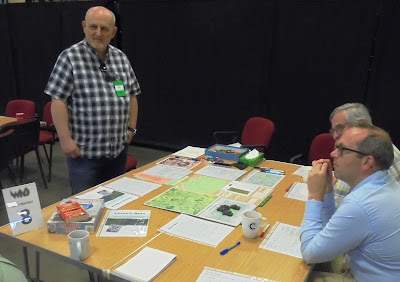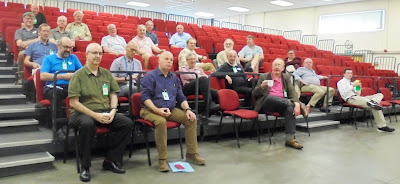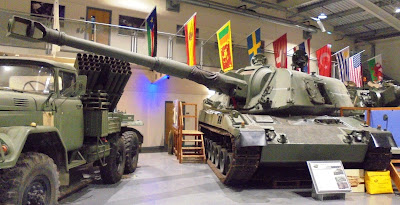FRIDAY 8th JULY
After my somewhat protracted journey to the UK Defence Academy, I passed through the security checkpoint – where I was given a temporary visitor's pass and a pass for my car – and made my way the the Churchill Reception, where I was given the key to my room in the Mountbatten Block. Having parked my car, I then unloaded my luggage and went off to find my room ...
... which turned out to be basic and functional, and which had its own en suite bathroom. It reminded me very much of the sort of accommodation offered by budget hotels or student Halls of Residence ... which is not surprising as that is what is is!
At 6.00pm I made my way over to Kitchener Hall, which is where we were all meeting up before dinner. The food was good, with a range of dishes on offer to meet most people's dietary requirements. I had the opportunity to have a chat with quite a few people before and over the meal, and it was great to be able to put faces and voices to people who I had previous only known online.
After dinner we all made our way to the lecture theatre in the Tech Block (which is otherwise known by the acronym DCMCI) where the Conference Organiser, Tim Gow, welcomed everybody and we were given the normal safety briefing. Once that was over, we were split into teams and made our way into the main room in the Tech Block, where we took part if the Plenary Game, which was entitled 'What If?'.
What If?
Each team had been given a list of situations from which they were to extrapolate what would have happened next. We chose one about the us of atomic bombs to stop the Chinese Communists along the Yalu River (as suggested by General Douglas MacArthur). We came to the conclusions that if this had happened:
- MacArthur would have been elected as the next President of the United States instead of Dwight D Eisenhower
- That the Chinese Communists would have been given more defensive weaponry by the USSR (i.e., jet fighters, anti-aircraft guns) but nothing that would enable them to continue the fight to conquer the whole of Korea
- Korea would be united under a US-sponsored (and supported) government
- The USSR would have reassessed its reliance on large ground forces, and shifted resources over to the development and production of both fission and fusion nuclear weapons ... and the means to deliver them (i.e., initially a long-range bomber force based on the Tupolev TU-4 and its jet-powered successors which is subsequently replaced by short, medium, and long-range land and sea-based missile systems).
- Both the USSR and US/NATO would have had few compunctions about deploying tactical (and some strategic) nuclear weapons in client states, and for non-aligned nations to develop their own nuclear weapons programmes. This proliferation would have made the World a far more unstable place, and once the genie was out of the bottle, nations would be less reluctant to threaten to use – and to use – nuclear weapons in local conflicts. For example, we envisaged the USSR occupying Berlin and threatening to drop a 'curtain' on nuclear bombs along the border between the FGR and DDR if the US/NATO tried to intervene
The teams then returned to the lecture theatre and a spokesperson from each team gave a three-minute presentation about their team's conclusions. Our teem was alone in choosing to look at what might have happened in Korea. Others had looked at what might have happened if the Confederacy had won the Battle of Gettysburg, the consequences of the death of Henry V and the defeat of the English army at Agincourt, the defeat of the Greeks at the Battle of Marathon, and the successful landing of a Spanish army in England after the victory of the Spanish Armada in 1588 amongst others.
After Dinner Games
By this time I was beginning to feel rather tired, but before going back to the Mountbatten Bloc to sleep, I made a quick circuit around the various After Dinner Games that were taking place. These included SPI's Dallas, ...
... The Road to Moscow, ...
... and the Blood of San Gennaro.
SATURDAY 9th JULY
After a somewhat disturbed night's sleep (mainly due to me not setting the controls of room's air conditioner correctly), I went over to the Victory Dining Room for breakfast. As I had expected, one could have everything from a simple bowl of cornflakes to a cooked. traditional English breakfast ... and it was interesting to note how many people opted for the latter!
After breakfast we made our wat back to the Tech Block for the conference's morning sessions. In my case I had opted to take part in a Matrix Game about the current war in Ukraine entitled Bandera II. I was given the role of Vladimir Putin ... and had to set my own objectives. Mine were:
- To remain in power
- To destroy Zelinsky
- To ensure that Ukraine re-joined the Russian Federation using whatever means were necessary
- To ensure the disunity of the Western powers, particularly the EU
The game lasted six rounds, and by the end it was obvious that the situation was fast developing into a stalemate, with the EU trying to broker some sort of resolution that was obviously not going to be acceptable to either side.
After lunch in the Victory Dining Room, we all returned to the Tech Block for the afternoon sessions. I had originally booked to take part in a game entitled If a single shot is fired, but as the designer felt that the game needed more development, this had been replaced by Armageddon at Waco.
This was a command decision game about the Waco Siege, and the players represented local law enforcement, the US military (actually the Texas National Guard), various Federal agencies (the FBI, ATF, and DEA), the leader of the Branch Dravidians (David Koresh), his supporters, and the press.
At the beginning, events unfolded in a not dissimilar way to what happened in real life. The ATF tried to serve a search and arrest warrant and were met with gunfire from the people inside the Mount Carmel Center ranch. The FBI were then tasked with resolving the situation ... and failed miserably. Finally, the National Guard moved in with pretty well every sort of weapon (e.g. tanks, APCs, armoured engineer vehicles) at their disposal (except for artillery!), and 'captured' the ranch. In the course of this lifting of the siege, Koresh was shot by one of his main supporters (me), who was then shot by the National Guard ... along with a large number of armed and unarmed civilians!
In the subsequent Congressional Inquiry (which was the last section of the game), the ATF, the FBI, and the National Guard were all censured. Only the DEA (who made strenuous efforts not to be given the lead in lifting the siege!) and the local Sherriff came out of it with unblemished reputations.
Whilst this game was going on, several other games were taking place, including one about the Battle of Shiloh, ...
... and the Battle of Maharajpur.
During the break between sessions, I had the opportunity to walk around and to see several other wargames that were either still taking place (The Battle Ortona), ...
... or that had finished including, The Wars of the Roses, ...
... and a figure version of the Waterloo Solitaire game.
I was struck by how impressive (and board game-like) the Warlord Epic Waterloo figures looked when based and spray-painted in gloss blue (French), red (Anglo-Dutch), and black (Prussians). They looked much better than plain wooden blocks even if they were not as 'pretty' as fully-painted figures might have been.
I had intended to sign up for Ukraine 2022, ...
... but was too late to get myself on the signing up sheet. As a result I had the opportunity to chat to several other attendees and to look at some of the other games that were taking place. These included Coyle's Best, which was based around the events featured in Harold Coyle's book, Team Yankee.
After dinner in the Victory Dining Room, the conference session restarted. I observed Petrograd Nights (a game about the political infighting and street fighting that took place in St Petersburg in the run up to the Bolshevik takeover) ...
... before taking on the role of the pilot of an Ilyushin Il-18 Naval Reconnaissance Aircraft in a command decision/role-play game about the mutiny aboard the Russian frigate, Storozhevoy (English: Sentry or Guardian) in November 1975.
The game saw some wonderful exchanges between the Head of the KGB (Yuri Andropov) and the commander of the local KGB Patrol Ship Brigade, with the intervention of the former seriously hampering the efforts of the latter to recapture the errant warship!
By the time this game finished, I was feeling tired, but before I made my way back to Mountbatten Block for what I hoped would be a better night's sleep I had a quick look at some of the other After Dinner Games that were taking place. These included Scout Base 947 (a Sci-Fi game) ...
... and Pieces of Eight, a pirate game.
SUNDAY 10th JULY
Despite the heat I slept somewhat better, and after a refreshing shower, I packed my bags, put them in my car, and returned my room key to Churchill Reception. I then made my way to the Victory Dining Room for breakfast, where I was able to have a chat with one of the Gurkhas who work at the Academy.
I had signed up for a game entitled Duck Hunting, which was about a semi-trained group of Ukrainian Militia trying to stall a possible Russian attack. It was a role-play game that used Google Maps to give the players a sense of the terrain in which they were to set up an ambush. I was assigned the role of squad commander (a sergeant) and had to collect my men from the car park of a local restaurant/truck stop.
Having made sure that everyone had enough equipment for our mission, I ordered a roadblock to be set up across a local motorway using two large truck that we 'requisitioned' from the truck stop. I then placed the squad in their ambush position in a row of houses that gave a good view of the roadblock and a long stretch of motorway that crosses a river and then marshland.
We did come under attack, first by a couple of armoured recce vehicles that stopped to investigate the roadblock from a distance. When they came off the motorway to move across country, we used some of our anti-tank weapons (and our very good sniper!) to destroy them and kill most of the vehicles' crew.
This initial attack was followed up by an attack by a tank and two armoured personnel carriers. We destroyed the tank, and then came under fire from the 30mm cannons on the APCs ... at which point we bugged out to a secondary ambush position that I had identified earlier in the game. This was just as well, as almost as soon as we had left, the houses we had been occupying were destroyed by artillery fire.
(It is worth noting that this game was designed by WD's youngest member, who is currently a student on the War Studies course at King's College London.)
This game finished somewhat earlier than expected, and it gave me time to observe The Battle for Villa Encogida Jamon ...
... which looked like it was a very entertaining game for all those who participated.
I also had the opportunity to observe the first few moves of Logistics, Logistics, Logistics, which proved to have some simple but effective rules for running opposing American Civil War railway lines that were bringing up men and supplies to the frontline. Getting the balance between the two right in circumstances that were never predictable presented the players with constantly changing supply problems that they had to solve. This game has all sorts of potential and could easily be developed to cover almost any historical period.
After lunch in the Victory Dining Room, it was time for the Wargame Developments Annual General Meeting.
This was attended by almost everyone who had been at the conference, and besides the usual reports and election of officers for the forthcoming year, it decided that if Knuston Hall was unlikely to be available as a venue for COW2023, the organising committee should look for an alternative venue. It was hoped that the Academy might be included on the list of potential venues, but this was very dependent upon it being available again.
Once the business of the AGM was completed, we all made our separate ways home ... and most of us were already planning what we might do at COW2023!
THE TANK HALL
One of the big attractions of the Tech Block at the Academy is the presence of what we all referred to as the Tank Hall. It houses the Academy's collection of modern (and not so modern) tanks, armoured personnel carriers, artillery, and aircraft ... and a visit to the Tank Hall is probably in itself worth the cost of going to the conference. The following photographs give some idea of the goodies that are on show.































































































